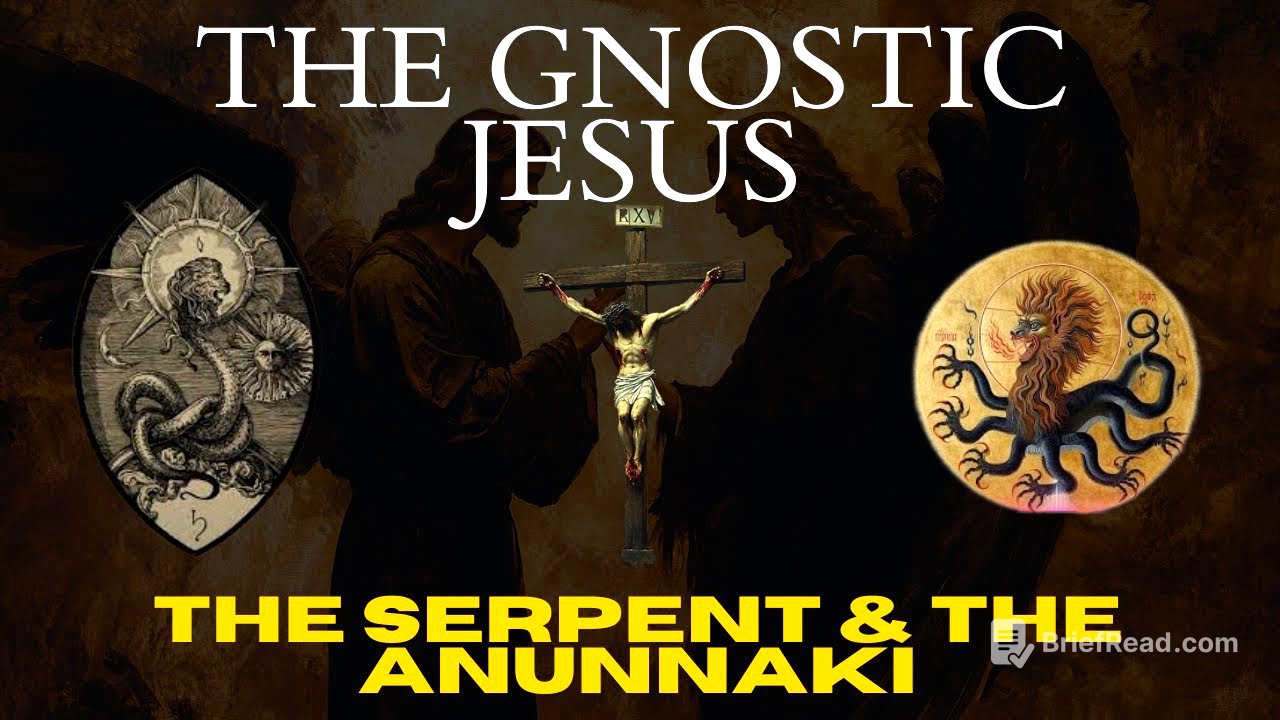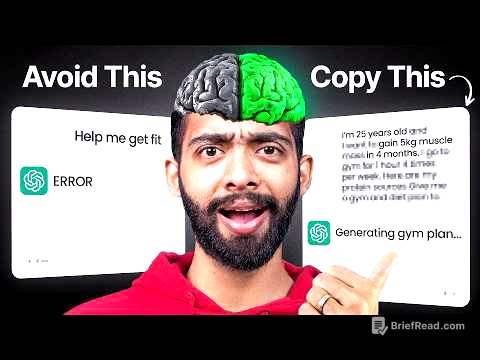TLDR;
This video explores the concept of the "first rebel" figure across various ancient traditions, including Sumerian, Greek, and Judeo-Christian myths. It examines how figures like Enki, Prometheus, Lucifer, and Jesus challenge divine authority to bring knowledge and enlightenment to humanity. The video also discusses Gnostic beliefs, particularly the idea of Yaldabaoth as a false god and the serpent in Eden as a liberator, and how these perspectives contrast with mainstream religious interpretations.
- Explores the archetype of the rebel figure in ancient myths.
- Discusses Gnostic beliefs and their alternative interpretations of religious stories.
- Examines the concept of forbidden knowledge and its impact on humanity.
Intro [0:00]
The video introduces the idea that many ancient stories have been reshaped and rebranded over time, often obscuring their original meanings. It poses the question of whether figures like Lucifer and Jesus, who are traditionally seen as separate, might actually be part of the same story—a story of rebellion and the pursuit of knowledge. The video aims to explore the story of the first rebel, who defied divine rules to liberate humanity.
The Rebel [1:56]
Across various ancient traditions, there exists a recurring figure who defies authority out of compassion. In Sumerian myth, Enki, the god of wisdom, betrays the supreme deity to grant humanity knowledge and civilization. In Christian tradition, Lucifer, the lightbringer, refuses to kneel and instead gifts enlightenment to mankind. Similarly, Jesus defies religious law, condemns the powerful, and preaches a gospel of self-realization.
Numbers 21 [2:50]
The video references a story from Numbers 21, where people are healed by looking at a bronze serpent raised on a pole by Moses. It draws a parallel to Jesus being "lifted up," questioning why Jesus would compare himself to the serpent, a symbol of rebellion and forbidden knowledge.
Enki [3:51]
The Sumerian texts describe Enki as the one who gifted humanity with forbidden knowledge, including civilization itself, writing, mathematics, agriculture, and medicine. In Sumerian tradition, knowledge was sacred and kept hidden. Enki defied this by giving humanity access to the "me," divine decrees that controlled civilization. He allowed humanity to "steal fire from heaven" and "eat from the Tree of Knowledge," enabling them to become greater. Enki's messenger, Ningishzida, is also represented as a serpent, guarding the tree of life or whispering knowledge. Enki, meaning "Lord of the Earth" and "Keeper of the Abzu," is portrayed as a being hidden from sight, waiting in the shadows.
Prometheus [5:49]
In Greek mythology, Prometheus is a Titan who defies Zeus by stealing fire from the heavens and giving it to humanity, granting them the power to create, think, and challenge the gods. Zeus punishes Prometheus by chaining him to a rock, where an eagle devours his liver daily. This serves as a warning against challenging the gods, highlighting the price of knowledge.
The Firebringer [7:21]
Prometheus's act of granting fire to humanity is seen as a means to elevate them beyond their primitive state, symbolizing knowledge, civilization, and transformation. Similar to Enki in Sumerian myths, Prometheus defies divine authority to empower humanity. The serpent in both Sumerian and Judeo-Christian traditions is reinterpreted not as a symbol of corruption but of wisdom. The video highlights a contradiction in the Bible, where the serpent offers knowledge and is cursed, yet Jesus is compared to the serpent lifted by Moses, symbolizing salvation. Serpents in ancient Greece were also connected to wisdom, as seen in the python of Delphi and the caduceus of Hermes. Fire and serpents share symbolic weight as forces of change, feared by those who seek control and revered by those who seek enlightenment.
"The Gnostics" [12:13]
The term "gnosticism" was applied by scholars to categorize diverse spiritual traditions that emerged alongside early Christianity. These groups, scattered across the Roman Empire, shared a belief that salvation was achieved through knowledge (gnosis), a direct personal understanding of divine truth, rather than blind faith.
Nag Hammadi [13:20]
In 1945, a collection of 13 leather-bound codices containing over 50 ancient texts was discovered in Nag Hammadi, Egypt. These manuscripts revealed a lost dimension of early Christianity, offering alternative visions of Jesus, creation, and the nature of God. The Nag Hammadi Library included texts declared heretical by the early church, such as the Gospel of Thomas, the Gospel of Philip, the Gospel of Truth, the Apocryphon of John, the Gospel of Mary, the Gospel of Judas, and the Pistis Sophia.
The Gospel of Judas [15:10]
In Gnostic texts, the distinction between Jesus and Lucifer is blurred, as both rebel against the demiurge and offer enlightenment. The Gospel of Judas portrays Judas not as a betrayer but as the only disciple who understood Jesus' true mission. Jesus reveals that the physical world is a prison and that death is an escape. The video questions whether Jesus, Lucifer, and Enki represent the same force: the bringer of wisdom, the liberator of minds, who defies false gods to reveal hidden truth.
Quid Est Veritas? [16:41]
The video presents a dialogue between Pilate and Jesus, where Jesus states that his kingdom is not of this world and that he came to bear witness to the truth. Pilate responds with the question, "What is truth?"
Yaldabaoth [18:09]
A radical Gnostic belief was that the god of the Old Testament, who demanded obedience and forbade knowledge, was not the true God but a false god called Yaldabaoth, the demiurge. The serpent in Eden was seen as humanity's liberator, and the true God existed beyond the material world. The demiurge created a false world, a prison of flesh and illusion, and forbade knowledge to keep humanity from discovering its divine nature.
The Kingdom [19:46]
Gnostics taught that salvation was not a reward for obedience but a realization of the hidden truth of reality, found within rather than in scripture or religious law. Jesus said that the kingdom of God is within and outside of oneself, emphasizing self-knowledge. This message threatened institutionalized religion, leading to the destruction of Gnostic Gospels and the persecution of their followers.
Ophiuchus [20:44]
The video discusses Ophiuchus, the forgotten zodiac sign depicting a man holding a serpent, symbolizing healing and knowledge. This figure is compared to Asclepius, Imhotep, and Enki, all of whom are associated with wisdom and defying the gods to protect humanity. The serpent is a recurring symbol of revealed truth.
Apocryphon of John [25:23]
The Apocryphon of John presents a Gnostic creation myth where the true God is a boundless, eternal source of perfect love and knowledge. Sophia, a divine being, desired to create something without the true Source's consent, giving birth to the imperfect Yaldabaoth, who declared himself the only God and created a false world. Yaldabaoth and his archons created Adam but could not animate him, so they placed him in the Garden of Eden and forbade him from eating from the Tree of Knowledge. Sophia sent the serpent to Eve, who ate the fruit and saw the world as a prison. Yaldabaoth cursed them, but the true God sent a fragment of the Divine Light into Adam, making him greater than Yaldabaoth.
Hereasy [31:33]
The Gnostic texts were outlawed, and their followers were persecuted. The Jesus of the Gnostics, the teacher and rebel, was replaced with a Jesus who obeyed and taught submission. The message was inverted, and the true divine spark was buried beneath doctrine, fear, and obedience. However, the old stories linger in whispers, lost texts, and symbols, waiting for those who are ready to see.
Credits [32:36]
Credits for the video.

![[Digimon Podcast] LiT Episode 94 - DigiEgg is Not On Crash](https://wm-img.halpindev.com/p-briefread_c-10_b-10/urlb/aHR0cDovL2ltZy55b3V0dWJlLmNvbS92aS9VYnBDbUdhbEJoVS9ocWRlZmF1bHQuanBn.jpg)







